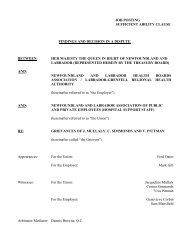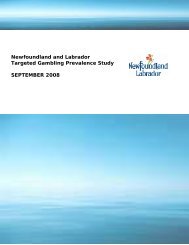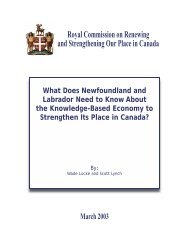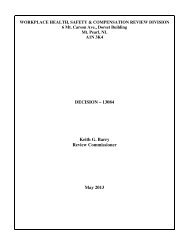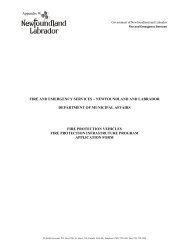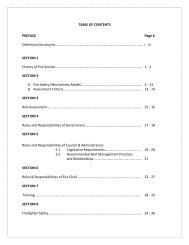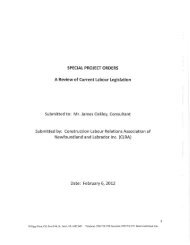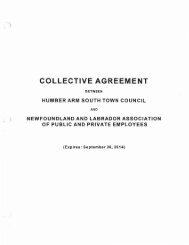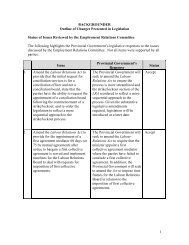Energy Plan - Government of Newfoundland and Labrador
Energy Plan - Government of Newfoundland and Labrador
Energy Plan - Government of Newfoundland and Labrador
Create successful ePaper yourself
Turn your PDF publications into a flip-book with our unique Google optimized e-Paper software.
Fiscal Regimes<br />
In our current environment <strong>of</strong> increasing oil <strong>and</strong> gas prices, it is important to<br />
ensure that our fiscal regimes reflect the increasing value <strong>of</strong> our petroleum<br />
resources. On the whole, our existing regimes do not adequately share this<br />
value between project developers <strong>and</strong> government. It is time to adjust the fiscal<br />
regime to reflect both the new economic environment for oil <strong>and</strong> gas exploration<br />
<strong>and</strong> production <strong>and</strong> the lessons learned from a decade <strong>of</strong> production under<br />
existing fiscal terms.<br />
Offshore Natural Gas Royalty Regime<br />
The province’s <strong>of</strong>fshore contains large natural gas deposits. The Provincial<br />
<strong>Government</strong> has developed an Offshore Natural Gas Royalty Regime that will<br />
ensure these resources are developed in the best interests <strong>of</strong> <strong>Newfoundl<strong>and</strong></strong>ers<br />
<strong>and</strong> <strong>Labrador</strong>ians, while at the same time providing those investors who develop<br />
the resource with a fair return.<br />
The Provincial <strong>Government</strong> developed the Offshore Natural Gas Royalty<br />
Regime by looking at best practices from around the world <strong>and</strong> at lessons<br />
we learned from our own experience over the past 10 years. We engaged<br />
Wood Mackenzie, a highly regarded international consulting firm, to provide<br />
international consulting assistance <strong>and</strong> benefited from ongoing consultation<br />
with industry participants.<br />
In designing our Offshore Natural Gas Royalty Regime, the province had five<br />
principal objectives:<br />
• Encouraging development <strong>of</strong> economic projects.<br />
• Obtaining higher royalties from a project when prices <strong>and</strong> pr<strong>of</strong>itability are<br />
higher <strong>and</strong> providing “downside protection” for developers in low price<br />
environments.<br />
• Creating a predictable <strong>and</strong> transparent system.<br />
• Designing a system that is sufficiently flexible to adapt to different types<br />
<strong>of</strong> projects.<br />
• Ensuring the regime is internationally competitive.<br />
The Offshore Natural Gas Royalty Regime is attached as Appendix D. The royalty<br />
has two components: Basic Royalty <strong>and</strong> Net Royalty. These components exist<br />
in the current oil royalty regimes, however, the mechanics <strong>of</strong> the Natural Gas<br />
Royalty terms are quite different.<br />
Basic Royalty provides a revenue stream to the province at all stages <strong>of</strong> a project.<br />
The basic royalty rate is linked to realized prices, rather than volumes or project<br />
economics as under existing oil royalty terms. This means that the province’s<br />
percentage share <strong>of</strong> the gross revenue from each project will be largely driven<br />
by price. This approach leads to greater transparency <strong>and</strong> ensures that the<br />
interests <strong>of</strong> the Provincial <strong>Government</strong> <strong>and</strong> industry are well-aligned.<br />
21



